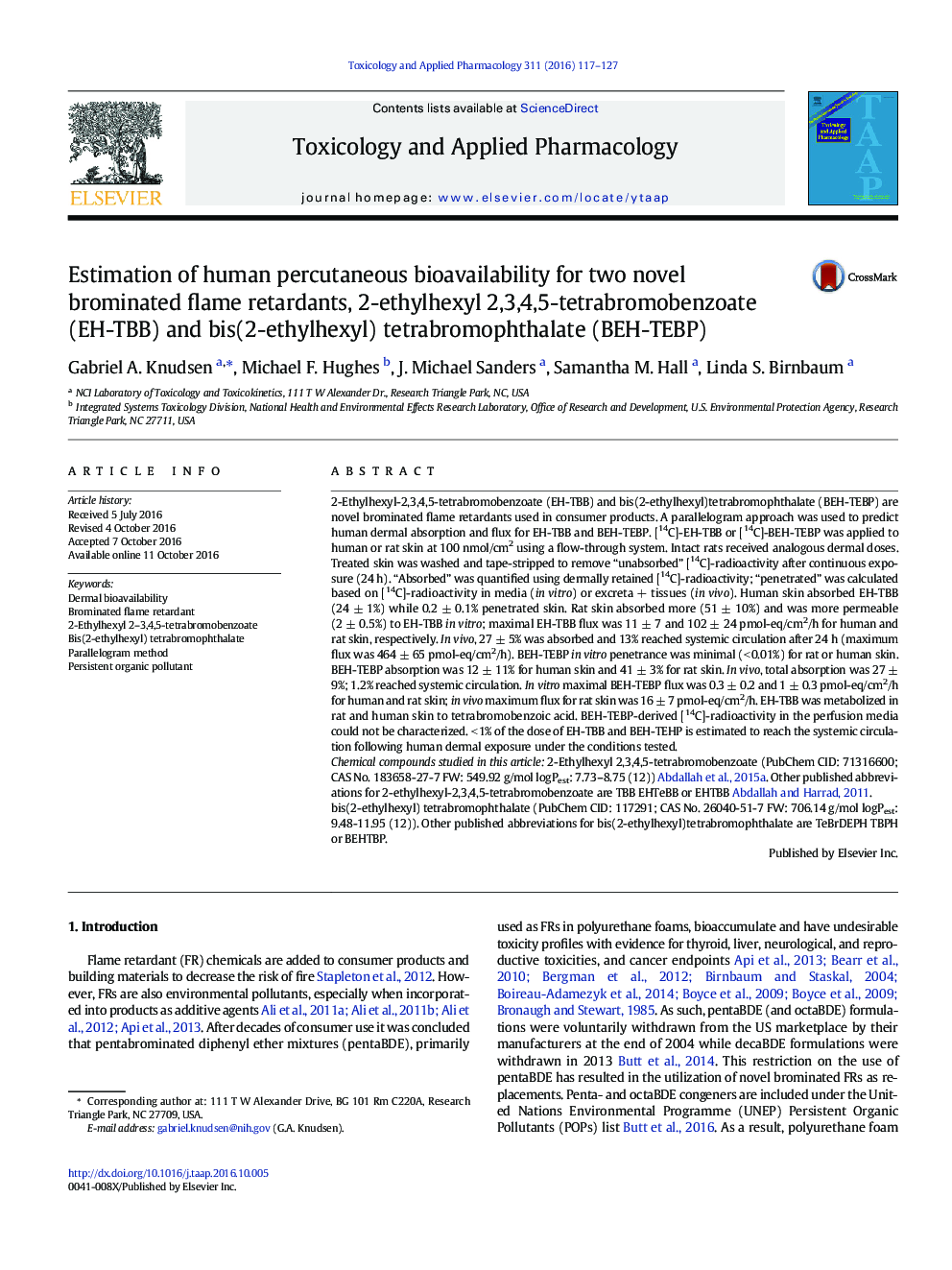| Article ID | Journal | Published Year | Pages | File Type |
|---|---|---|---|---|
| 5558612 | Toxicology and Applied Pharmacology | 2016 | 11 Pages |
â¢Human skin maximal flux was 11 ± 7 (EH-TBB) & 0.3 ± 0.2 (BEH-TEBP) pmol-eq/cm2/h.â¢Predicted systemic bioavailability was < 1% for either chemical after 24 h.â¢Skin retained EH-TBB & BEH-TEBP after 24 h dermal exposure.â¢EH-TBB was hydrolyzed to tetrabromobenzoic acid; BEH-TEBP was not metabolized.â¢Skin contact is an important route of human exposure to EH-TBB & BEH-TEBP.
2-Ethylhexyl-2,3,4,5-tetrabromobenzoate (EH-TBB) and bis(2-ethylhexyl)tetrabromophthalate (BEH-TEBP) are novel brominated flame retardants used in consumer products. A parallelogram approach was used to predict human dermal absorption and flux for EH-TBB and BEH-TEBP. [14C]-EH-TBB or [14C]-BEH-TEBP was applied to human or rat skin at 100 nmol/cm2 using a flow-through system. Intact rats received analogous dermal doses. Treated skin was washed and tape-stripped to remove “unabsorbed” [14C]-radioactivity after continuous exposure (24 h). “Absorbed” was quantified using dermally retained [14C]-radioactivity; “penetrated” was calculated based on [14C]-radioactivity in media (in vitro) or excreta + tissues (in vivo). Human skin absorbed EH-TBB (24 ± 1%) while 0.2 ± 0.1% penetrated skin. Rat skin absorbed more (51 ± 10%) and was more permeable (2 ± 0.5%) to EH-TBB in vitro; maximal EH-TBB flux was 11 ± 7 and 102 ± 24 pmol-eq/cm2/h for human and rat skin, respectively. In vivo, 27 ± 5% was absorbed and 13% reached systemic circulation after 24 h (maximum flux was 464 ± 65 pmol-eq/cm2/h). BEH-TEBP in vitro penetrance was minimal (< 0.01%) for rat or human skin. BEH-TEBP absorption was 12 ± 11% for human skin and 41 ± 3% for rat skin. In vivo, total absorption was 27 ± 9%; 1.2% reached systemic circulation. In vitro maximal BEH-TEBP flux was 0.3 ± 0.2 and 1 ± 0.3 pmol-eq/cm2/h for human and rat skin; in vivo maximum flux for rat skin was 16 ± 7 pmol-eq/cm2/h. EH-TBB was metabolized in rat and human skin to tetrabromobenzoic acid. BEH-TEBP-derived [14C]-radioactivity in the perfusion media could not be characterized. < 1% of the dose of EH-TBB and BEH-TEHP is estimated to reach the systemic circulation following human dermal exposure under the conditions tested.Chemical compounds studied in this article2-Ethylhexyl 2,3,4,5-tetrabromobenzoate (PubChem CID: 71316600; CAS No. 183658-27-7 FW: 549.92 g/mol logPest: 7.73-8.75 (12)) Abdallah et al., 2015a. Other published abbreviations for 2-ethylhexyl-2,3,4,5-tetrabromobenzoate are TBB EHTeBB or EHTBB Abdallah and Harrad, 2011.bis(2-ethylhexyl) tetrabromophthalate (PubChem CID: 117291; CAS No. 26040-51-7 FW: 706.14 g/mol logPest: 9.48-11.95 (12)). Other published abbreviations for bis(2-ethylhexyl)tetrabromophthalate are TeBrDEPH TBPH or BEHTBP.
